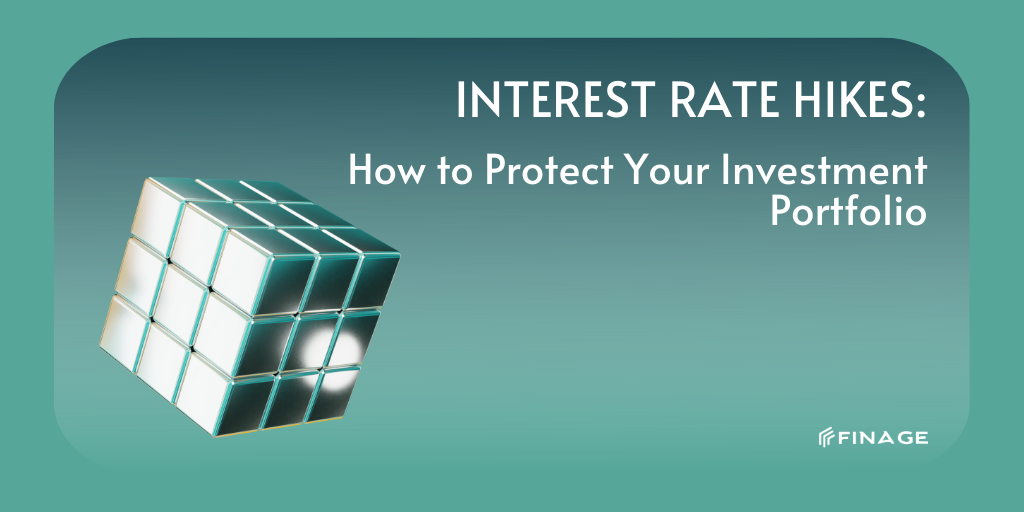Interest Rate Hikes: How to Protect Your Investment Portfolio
6 min read • June 24, 2024

Introduction
Interest rate hikes are a significant event in the financial markets, impacting various asset classes and investment strategies. When central banks, such as the Federal Reserve, decide to increase interest rates, it is typically to combat rising inflation or to stabilize the economy during periods of rapid growth. These decisions ripple through the financial markets, influencing the cost of borrowing, consumer spending, and business investment. As a result, investors need to stay informed about central bank policies and prepare to adjust their portfolios to mitigate potential risks and capitalize on emerging opportunities (Federal Reserve).
As interest rates rise, different types of investments react in varied ways. Fixed-income securities, such as bonds, are directly affected by rate hikes. When interest rates increase, the prices of existing bonds generally fall, as newer bonds offer higher yields, making older issues less attractive. This inverse relationship can erode the value of bond portfolios, particularly those with long maturities. Meanwhile, equities may also face headwinds as higher borrowing costs can squeeze corporate profit margins and dampen consumer spending. However, certain sectors, like financial services, may benefit from higher rates due to increased lending margins (Investopedia, Forbes).
This article explores the effects of interest rate hikes on different investments and offers strategies to safeguard and optimize your portfolio during periods of rising interest rates. By understanding the dynamics of how various asset classes respond to changes in interest rates, investors can make more informed decisions. Strategies such as diversification, focusing on shorter-duration bonds, and investing in sectors less sensitive to interest rate fluctuations can help protect investment portfolios. Additionally, maintaining adequate liquidity and considering inflation-protected securities can provide a buffer against market volatility. Active management and tactical adjustments are also essential to navigate the complexities of a rising interest rate environment successfully.
Understanding the Impact of Interest Rate Hikes
Effects on Fixed-Income Investments
Interest rate hikes have a direct impact on fixed-income investments, such as bonds. When interest rates rise, the prices of existing bonds typically fall, as newer bonds are issued with higher yields, making older bonds less attractive. This inverse relationship can lead to capital losses for bondholders. For instance, long-term bonds are more sensitive to interest rate changes than short-term bonds due to their longer duration and exposure to interest rate risk.
Effects on Equities
The impact of rising interest rates on equities can be multifaceted. Higher interest rates increase borrowing costs for companies, potentially squeezing profit margins and reducing earnings growth. Additionally, consumer spending may decline as borrowing costs rise, leading to lower revenue for businesses. However, not all sectors are equally affected. Financial stocks, such as banks and insurance companies, often benefit from rising rates as they can charge higher interest rates on loans and earn more from their reserves (Forbes).
Effects on Real Estate
Real estate investments can also be impacted by interest rate hikes. Higher interest rates lead to increased mortgage rates, which can dampen demand for housing and commercial properties. This can result in slower price appreciation or even declining property values. However, well-located properties with strong rental demand may still perform well, especially if they offer inflation-protected income streams.
Strategies to Protect Your Investment Portfolio
Diversification
Diversification remains a cornerstone strategy for protecting your investment portfolio during interest rate hikes. By spreading investments across various asset classes, sectors, and geographies, you can reduce the impact of rate increases on your overall portfolio. Diversification helps mitigate risks associated with specific asset classes and ensures that gains in one area can offset losses in another.
Focus on Shorter Duration Bonds
To mitigate the negative impact of rising interest rates on fixed-income investments, consider focusing on shorter-duration bonds. Shorter-duration bonds are less sensitive to interest rate changes and have less price volatility compared to long-term bonds. Alternatively, you can invest in bond funds or exchange-traded funds (ETFs) that focus on short-duration or floating-rate bonds, which adjust their interest payments based on prevailing rates.
Invest in Equities with Strong Fundamentals
Equities with strong fundamentals and healthy balance sheets are better positioned to withstand the challenges posed by rising interest rates. Focus on companies with low debt levels, consistent earnings growth, and the ability to maintain or increase dividends. Sectors such as technology, healthcare, and consumer staples often include companies with these attributes. Additionally, consider adding exposure to financial stocks, which tend to benefit from higher interest rates.
Real Estate Investment Trusts (REITs)
While rising interest rates can negatively impact real estate prices, certain types of real estate investment trusts (REITs) may still perform well. REITs that invest in properties with long-term leases and inflation-protected income streams, such as industrial and healthcare REITs, can offer resilience in a rising rate environment. These investments provide regular income and can act as a hedge against inflation.
Consider Inflation-Protected Securities
Inflation-protected securities, such as Treasury Inflation-Protected Securities (TIPS), can provide a hedge against rising interest rates and inflation. TIPS adjusts its principal value based on changes in the Consumer Price Index (CPI), ensuring that the investment keeps pace with inflation. This makes them an attractive option for preserving purchasing power in a rising rate environment.
Maintain Adequate Liquidity
Maintaining adequate liquidity in your portfolio is essential during periods of rising interest rates. Having a cash buffer allows you to take advantage of new investment opportunities that may arise as markets adjust to higher rates. It also provides flexibility to rebalance your portfolio without the need to sell assets at potentially unfavorable prices.
Active Management and Tactical Adjustments
Active Management
Active management involves making tactical adjustments to your portfolio based on current market conditions and economic outlooks. This approach can be particularly effective during periods of rising interest rates, as it allows you to respond to changing market dynamics in real time. Consider working with a financial advisor or investment manager who can help identify opportunities and adjust your portfolio to align with your financial goals.
Tactical Adjustments
Tactical adjustments involve making short-term changes to your portfolio to capitalize on market opportunities or mitigate risks. During periods of rising interest rates, this might include increasing exposure to sectors that benefit from higher rates, such as financials, or reducing exposure to rate-sensitive investments, such as long-term bonds. Regularly reviewing and rebalancing your portfolio ensures that it remains aligned with your risk tolerance and investment objectives.
Conclusion
Interest rate hikes present both challenges and opportunities for investors. By understanding the impact of rising rates on different asset classes and employing strategies such as diversification, focusing on shorter-duration bonds, investing in equities with strong fundamentals, and maintaining liquidity, you can protect and optimize your investment portfolio. Active management and tactical adjustments can further enhance your ability to navigate the complexities of a rising interest rate environment. Staying informed and proactive in your investment approach will help you achieve your financial goals despite the changing economic landscape.
You can get your Real-Time and Historical Market Data with a free API key.
Build with us today!
Claim Your Free API Key Today
Access stock, forex and crypto market data with a free API key—no credit card required.

Stay Informed, Stay Ahead
Finage Blog: Data-Driven Insights & Ideas
Discover company news, announcements, updates, guides and more


